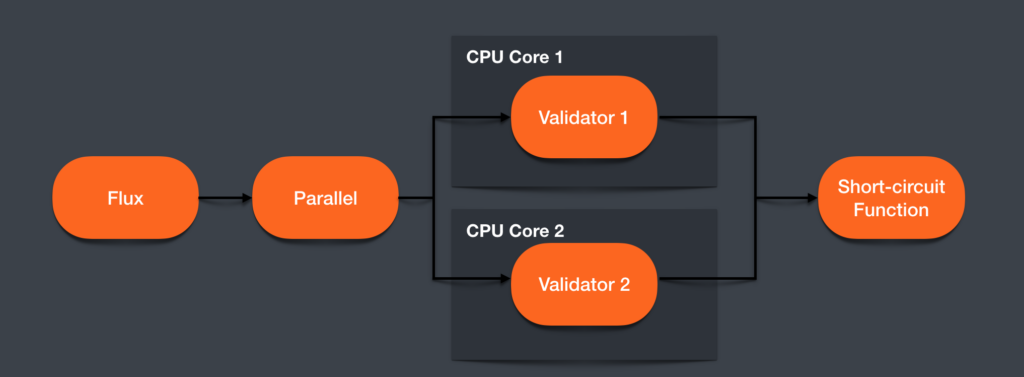Parallel Short-Circuiting With Reactive Programming

Dealing with asynchronous and parallel validation
There are scenarios in Reactive Programming when the outcome of a code block is depends on several separate independent expressions (jobs). If any of them goes wrong (or right depending on the problem), you can already decide about final result and you don’t need to wait for the outcome of every single expression.
Think of it like a short-circuit in if statements, but in a parallel manner. In evaluating A && B, if A is false, then B is short-circuited (not evaluated) because it has no effect on the end result.
One of the most common use cases is when you are developing an enterprise application. You might want to validate an end-user’s request based on current business status of system before applying the request to the system.
To validate a request, you might need to do multiple validations. If all of them validate the request successfully, then we can continue with serving the request.
However, if any of the validators fails to validate, then user’s request is invalid, regardless of all other validators result.
We will do all of the validations asynchronously and in parallel as their results are independent of each other. As soon as any of them fails, we don’t want to waste time any more and respond back to the user.
Now let’s see some code.
Building blocks
We have an Interface that every validator class is going to implement:
public interface Validator {
CompletableFuture<ValidationResponse> validate();
}
Next is our first validator which returns a failed response after 2 seconds:
public class Validator1 implements Validator{
public CompletableFuture<ValidationResponse> validate() {
return CompletableFuture.supplyAsync(this::doStuff);
}
public ValidationResponse doStuff() {
System.out.println("Validator1 started. Time: " + Instant.now());
try {
TimeUnit.SECONDS.sleep(2);
} catch (InterruptedException e) {
e.printStackTrace();
}
return new ValidationResponse(false, "Order already exists");
}
}
Our second validator returns a success response after 5 seconds:
public class Validator2 implements Validator{
public CompletableFuture<ValidationResponse> validate() {
return CompletableFuture.supplyAsync(this::doStuff);
}
public ValidationResponse doStuff() {
System.out.println("Validator2 started. time: "+ Instant.now());
try {
TimeUnit.SECONDS.sleep(5);
} catch (InterruptedException e) {
e.printStackTrace();
}
return new ValidationResponse(true);
}
}
The ValidationResponse can be any object, like this:
public class ValidationResponse {
private boolean isSuccessful;
private String reason;
public ValidationResponse(boolean isSuccessful) {
this.isSuccessful = isSuccessful;
}
public ValidationResponse(boolean isSuccessful ,String reason) {
this.isSuccessful = isSuccessful;
this.reason = reason;
}
}
So what we aim for is to validate the user’s request and reject it after 2 secs and do not wait for the other validator.
Don’t use java 8 Stream API
First solution that might come to mind is using parallel feature of java Stream API and then use a short circuit operator like findFirst ().
public void validate(){
Validator1 validator1 = new Validator1();
Validator2 validator2 = new Validator2();
CompletableFuture<ValidationResponse> cfValidation2 = validator2.validate();
CompletableFuture<ValidationResponse> cfValidation1 = validator1.validate();
List<CompletableFuture<ValidationResponse>> validationFutures = Arrays.asList(cfValidation1, cfValidation2);
CompletableFuture<ValidationResponse> validationResponseCompletableFuture;
Mono<ValidationResponse> validationResponseMono;
validationFutures.stream().parallel()
.filter( validationFuture -> checkValidationResponse(validationFuture))
.map(e -> {
System.out.println("after filter. Time: " + Instant.now() );
return e;
})
.findFirst()
.ifPresent(validationFuture -> System.out.println("after findFirst. Time: " + Instant.now() ));
}
and checkValidationResponse log the time when each validationResponse hit the method and at the end just does a blocking join() to return.
private Boolean checkValidationResponse(CompletableFuture<ValidationResponse> validationResponseCF) {
return validationResponseCF.thenApply(validationResponse -> {
if (validationResponse.isFailed()){
System.out.println("found failed one. Time: " + Instant.now()+ " Thread is " + Thread.currentThread().getName());
return true;
}
System.out.println("found normal one. Time: " + Instant.now() + " Thread is " + Thread.currentThread().getName());
return false;
}).join();
}
If we run the code, the terminal looks like this:
Validator2 started. time: 2019-06-12T11:49:50.808Z
Validator1 started. Time: 2019-06-12T11:49:50.808Z
found failed one. Time: 2019-06-12T11:49:52.828Z Thread is ForkJoinPool.commonPool-worker-2
after filter. Time: 2019-06-12T11:49:52.829Z
found successful one. Time: 2019-06-12T11:49:55.827Z Thread is ForkJoinPool.commonPool-worker-1
after findFirst. Time: 2019-06-12T11:49:55.828Z
This is very interesting as you can see Java 8 Stream API worked as we aimed until findFirst(). And although it already has the first response, but the findFirst() does not pass it down the stream until all threads who are currently in progress (not all total jobs) finish their tasks and that’s by design to guaranty that the application code after the stream api, won’t rise any concurrent access issue to any of the data structures we are dealing with during jobs process.
Stream API parallel mode uses by default Threadpool with the size of available processors, And in our case it unnecessarily waits also for Validator2 to finish it’s job and then passes down the response of Validator1.
So Java 8 Stream API did not work efficiently for this specific problem unless extra wait for results of concurrent jobs are acceptable.
Second solution: using reactive streams and project reactor
Now we are going to do the same test using project reactor. Project reactor is an implementation of reactive streams from Pivotal.
For using it, Add the following dependency to your project:
<dependency>
<groupId>io.projectreactor</groupId>
<artifactId>reactor-core</artifactId>
<version>3.2.10.RELEASE</version>
</dependency>
And the code :
Mono<ValidationResponse> cfValidation2Mono = Mono.fromFuture(cfValidation2);
Mono<ValidationResponse> cfValidation1Mono = Mono.fromFuture(cfValidation1);
List<Mono<ValidationResponse>> validationMonos = Arrays.asList(cf2ValidationMono, cf1ValidationMono);
Flux.fromStream(validationMonos.stream())
.parallel()
.runOn(Schedulers.parallel())
.flatMap(mono -> mono)
.filter(vr -> checkValidationResponse(vr))
.sequential()
.next()
.switchIfEmpty(Mono.just(new ValidationResponse(true)))
.block();
System.out.println(String.format("Validations Result is ready. time: %s , success: %s",Instant.now(), validationResponse.isSuccessful()));
Let’s have a closer look at the way we assembled the reactive pipeline.
Schedulers.parellel() uses a fixed threadpool with the size of number of cpu cores. If you need more threads, you can use Schedulers.elastic().
flatMap is needed to flatten ParallelFlux<Mono<ValidationResponse>> to ParallelFlux<ValidationResponse>.
sequential() changes the pipeline from parallel to flux again for downstream processors.
switchIfEmpty() subscribes to another publisher if it receives no element. So in our case we if receive no element, it means all validators returned success responds, so we just subscribe to Mono.just(newValidationResponse(true)).
Now time to run this piece of code and check the behaviour:
Validator1 started. Time: 2019-06-12T12:52:09.623Z
Validator2 started. time: 2019-06-12T12:52:09.623Z
[DEBUG] (main) Using Console logging
found failed one. Time: 2019-06-12T12:52:11.651Z Thread is ForkJoinPool.commonPool-worker-2
Validations Result is ready. time: 2019-06-12T12:52:11.651Z , success: false
As you can see, as soon as the failed validation happened, we managed to end the flow and did not waste time waiting for the other validator as the final result is already determined.
Also it stops the other concurrent threads, in this case Validator2, as soon as it finds out validation result. So it’s a proper parallel short circuit.
Conclusion
Project reactor provides a very powerful API to do parallel and non-blocking way of programming. Running concurrent jobs and determining the first job which meets a certain condition as quickly as possible, is easily doable by project reactor out of the box processors while Java 8 Stream API waits for all concurrent threads to finish processing first.
Project reactor also interrupts concurrent jobs when first job has already completed. In certain scenarios it can be a great performance boost compare to using Java Stream API.
You can use this pattern when you have complex business validation for a user’s request in enterprise applications.
Related Reactive Programming Articles
Interested in more Reactive Programming content? Check out one of our other blog posts ‘Retry functionality in a reactive programming context‘ by Erwin de Gier
